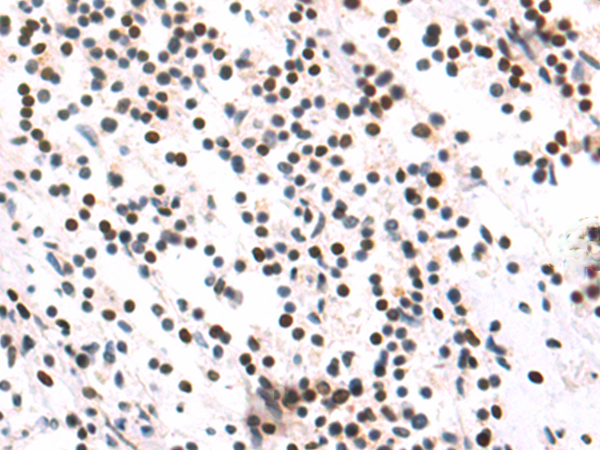
| WB | 咨询技术 | Human,Mouse,Rat |
| IF | 咨询技术 | Human,Mouse,Rat |
| IHC | 1/50-1/100 | Human,Mouse,Rat |
| ICC | 技术咨询 | Human,Mouse,Rat |
| FCM | 咨询技术 | Human,Mouse,Rat |
| Elisa | 1/5000-1/10000 | Human,Mouse,Rat |
| Aliases | NUMA; NMP-22 |
| Host/Isotype | Rabbit IgG |
| Antibody Type | Primary antibody |
| Storage | Store at 4°C short term. Aliquot and store at -20°C long term. Avoid freeze/thaw cycles. |
| Species Reactivity | Human, Mouse |
| Immunogen | Synthetic peptide of human NUMA1 |
| Formulation | Purified antibody in PBS with 0.05% sodium azide and 50% glycerol. |
+ +
以下是关于NUMA1抗体的3篇参考文献及其摘要概述:
---
1. **文献名称**:*Autoantibodies against nuclear mitotic apparatus (NuMA) in primary biliary cirrhosis*
**作者**:Gasztonyi B, et al.
**摘要**:该研究探讨了原发性胆汁性肝硬化(PBC)患者中抗核有丝分裂器(NuMA)自身抗体的存在,发现NUMA1抗体可能与疾病特异性自身免疫反应相关,并提示其在诊断中的潜在标志物作用。
2. **文献名称**:*The nuclear mitotic apparatus protein NuMA is a common autoantigen in diverse autoimmune diseases*
**作者**:Trost DC, et al.
**摘要**:研究发现NUMA1蛋白在多类自身免疫疾病(如系统性红斑狼疮、干燥综合征)中作为自身抗原被识别,其抗体可能与疾病活动性及特定临床表现相关。
3. **文献名称**:*NuMA as a potential prognostic marker and therapeutic target in cancer*
**作者**:Hieda M, et al.
**摘要**:该文献提出NUMA1在多种癌症中异常表达,其抗体可用于检测肿瘤细胞分裂异常,并探讨了NUMA1作为癌症预后标志物或治疗靶点的可能性。
---
**备注**:若需获取具体发表年份或期刊,建议通过PubMed或Google Scholar进一步检索标题或作者名。部分早期文献可能需通过DOI或图书馆资源访问全文。
The NUMA1 (Nuclear Mitotic Apparatus Protein 1) antibody targets the NUMA1 protein, a large structural component of the nuclear matrix involved in maintaining nuclear architecture and mitotic spindle organization during cell division. NUMA1. encoded by the *NUMA1* gene, contains coiled-coil domains that mediate its self-assembly and interaction with dynein/dynactin complexes, ensuring proper spindle pole formation. During interphase, NUMA1 localizes to the nucleus, contributing to nuclear integrity, and redistributes to spindle poles during mitosis to anchor microtubules.
NUMA1 antibodies are widely used in research to study cell cycle dynamics, nuclear organization, and mitotic errors. In diagnostic contexts, anti-NUMA1 autoantibodies are detected in autoimmune disorders, notably in a subset of systemic lupus erythematosus (SLE) patients, where they correlate with specific clinical manifestations. Additionally, NUMA1 dysregulation or chromosomal translocations involving *NUMA1* (e.g., t(11;14) in hematologic malignancies) have been linked to cancer, making these antibodies valuable in oncology research.
Experimental applications include immunofluorescence, immunohistochemistry, and Western blotting to visualize NUMA1's spatial-temporal localization. Its role as both a structural protein and an autoantigen underscores its dual significance in cellular biology and autoimmune pathogenesis, driving ongoing studies into its mechanisms and therapeutic implications.
×